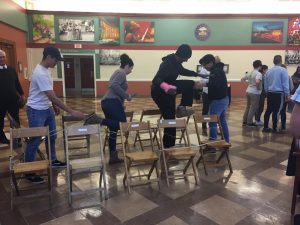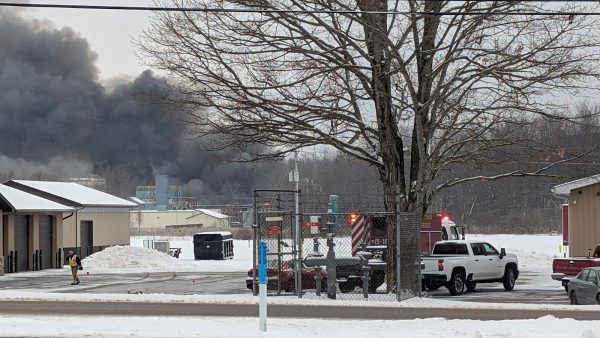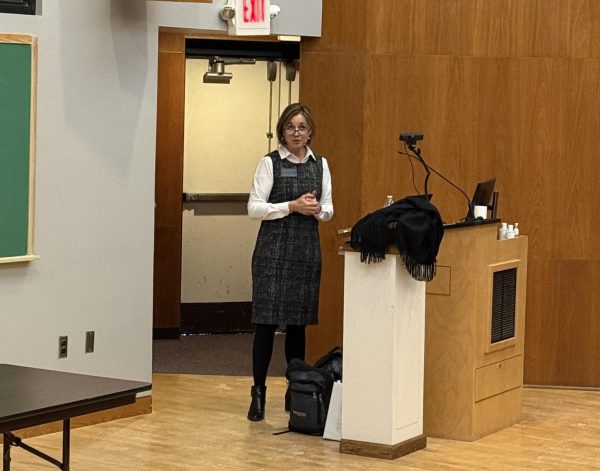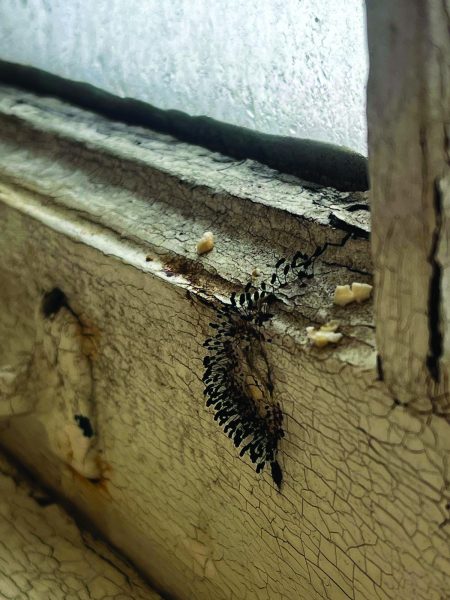Campus holds simulation for refugee journey
The Global Citizen Scholars Program held its first refugee simulation in Shultz Banquet Hall on Tuesday, April 17.
Allegheny Students participated in a 30 minute educational simulation that enhanced their perspective on refugees and what the resettlement process inside a refugee camp is like. The point of this simulation, according to the Global Citizen Scholars Program, was to strike curiosity and sympathy for those who have gone, are going or will go through, this strenuous and often heartbreaking process.
The simulation was followed up with a reflection period for students to discuss their experience and hear from two of their peers who have gone through the resettlement process.
“We’re looking for you to go through the simulation and hold any observations you have for the reflection period,” said Professor of French Laura Reeck. “We want to emphasize that this is not a game and to go through this with seriousness and practicality.”
In the beginning of the simulation, groups of three to four students were assigned cards that had a pseudonym family name, descriptions of the members of the family, the country they were leaving and the country they hoped to travel to. Each card explained why the family needed to escape their country with many fleeing for fear of their lives and political persecution.

Students cross an obstacle course made of rope to symbolize the hardships refugees face while traveling to refugee camps during the refugee simulation.
For the first task students had to cross a ropes course in a zigzag formation which was symbolic of the difficulties these families faced in real life. If a student touched the rope, their entire family was sent to the back of the line.

One student carries another to cross an obstacle faster during the refugee simulation in Shultz Banquet Hall on Tuesday, April 17, 2018.
“Where you started first, you would actually have 100 people racing to get into those lines,” said photo journalist and activist Maitham Basha-Agha. “Once you cross, you do not turn around to focus on what’s next. You have to turn back to make sure your whole family is right there with you.”
After passing through the obstacle course students were introduced to the first of five tables, which were used to signify the refugee camp’s entrance point.
Students were asked to fill out a form identifying who they were and why they left their country. This was challenging for most because of a language barrier. The instructions given to the students to fill out the form and the form itself were in Spanish. Responses to the questions had to be written in Spanish as well.
After being admitted into the refugee camp, students needed to hold onto their paperwork and were given a checklist. To be accepted and processed into another country by the United High Commission for Refugees, the final table within the camp, the participant had to be granted four check marks and signatures.
The next three tables were medical, nutrition and school. Students had to pass their medical exam, and if they failed, they were told they had to wait anywhere from three hours to six months before they were allowed to go back. At nutrition, students were handed small cups of cheerios and water with some receiving the food and drink while others were not. At the last station, students were expected to go through schooling and were taught the name of vegetables in French.
“You’re fleeing your country and refugee camps are cutting a lot of funding,” Basha-Agha said. “When you went to the education table there was only vegetables because you don’t get meat at refugee camps.”
Only two groups out of about eight made it to the UNHCR table and were admitted into a different country. All paperwork, signatures and the ability to name the vegetables learned in French were needed to pass.
Following the simulation was a reflection period where students were introduced to Sara Waya, ’19, and Daniel Basheer, ’21, who came to America as refugees.
Basheer’s family is originally from Iraq, but fled to Jordan because of the ongoing war. It took them 17 years to be accepted into the U.S. by the United Nations.
“It was 17 years of rejection,” Basheer said. “We were told to sell everything within a month so we would have everything ready. We sold our furniture so we were sleeping on the floor and a year went by when they told us the Australia plans fell through.”
At that point in Basheer’s life, he had dropped out of school and his family did not have decent paying jobs because they were not recognized as citizens in Jordan. Basheer’s mother filed for status as a woman in danger to the U.N. because of family issues which made her a higher priority and allowed the family to finally move, according to Basher.
Waya and her family also moved to the U.S. due to a civil war within South Sudan.
“I was eight when we left and we went back and forth between Uganda and Kenya before ending up in Egypt,” Waya said. “We applied for visas and ended up waiting there for three years.”
Waya, her mother, and older sister were the only ones to make it to Egypt, according to Waya. Her four other siblings had been married off at a young age due to a tradition within South Sudan and Waya’s mother was unable to file paperwork for them because of the marriages. By the time Waya and her family were resettled in the U.S. another one of her sisters had been sent to Australia.
“They place you where it is most convenient and not where you want to go,” Waya said.
The Global Citizen Scholars began to focus on new Americans, refugees and asylum seekers because they believed it was an important topic. GCS members worked with Viva La Casa, a temporary shelter in Buffalo, that cares for individuals displaced from their home countries and are trying to find permanent residence in Canada, according to Director of Civic Engagement David Roncolato. GCS also worked with the Catholic Relief Services where they first witnessed the simulation being implemented and thought it should be shared with Allegheny’s campus to bring more awareness surrounding refugees.
“I’ve talked to students who have refugee experience or have been displaced for other reasons here at Allegheny and they lower their voice because it’s not something that the culture at Allegheny accepts or knows,” Roncolato said. “It’s not what an Allegheny student looks like.”
Daniel Larson, ’19, admitted he had been a person that did not know much about refugees until he became involved with GSC. Through the organizations work with Catholic Relief Services he was able to create sustainable relationship with refugees and learn their stories and the situations they had been in.
Larson, along with Jacob Gagliastri, ’19, were both part of the simulation and spoke in Spanish and French to show the language barriers most refugee face.
“These refugees are coming from various countries and are going to countries that might not speak their language and the refugee camp itself might be in a country that doesn’t speak their native tongue,” Larson said. “There’s an influx of language and stimuli and this simulation highlighted the difficulties and barriers refugees would face.”
Gagliastri mentioned the advantage learning French has given him, especially when interacting with refugees because many do not speak English. While helping two refugees from the Congo write a resume, neither spoke English and he had to revert to French to help them. Gaglastri has also interviewed refugee families and listened to their stories which has been one of the hardest parts for him.
“This woman said a quote that has stuck with me till this day and that’s ‘Life as a refugee, it’s like it’s in limbo,’” Gagliastri said.
Waya and Basheer also expressed how long the refugee process tasks and the language barrier accompanied with being a refugee. English is Waya’s third language, while the first is an African language. English is Basheer’s second, and at home he speaks Arabic, but even this causes difficulties because he speaks a Jordanian dialect of Arabic and his older siblings speak Iraqi. Basha-Agha was also a refugee who fled from Iraq to Jordan and ended up in America, and he too spoke Arabic as his first language.
“You have two students here who came from nothing and wanted to make something of themselves,” Basha-Agha said. “We really need to understand that not all refugees and people that come from this specific region are our enemies and we come here to try and make a better life for ourselves.”





